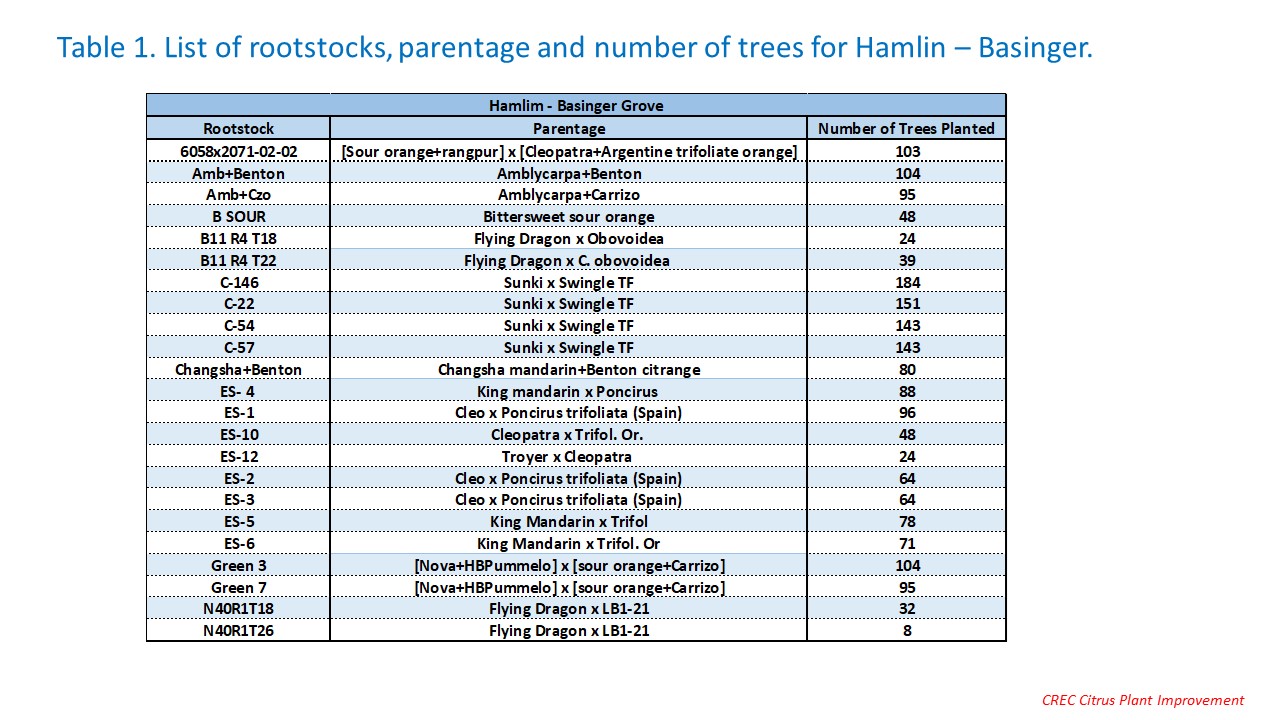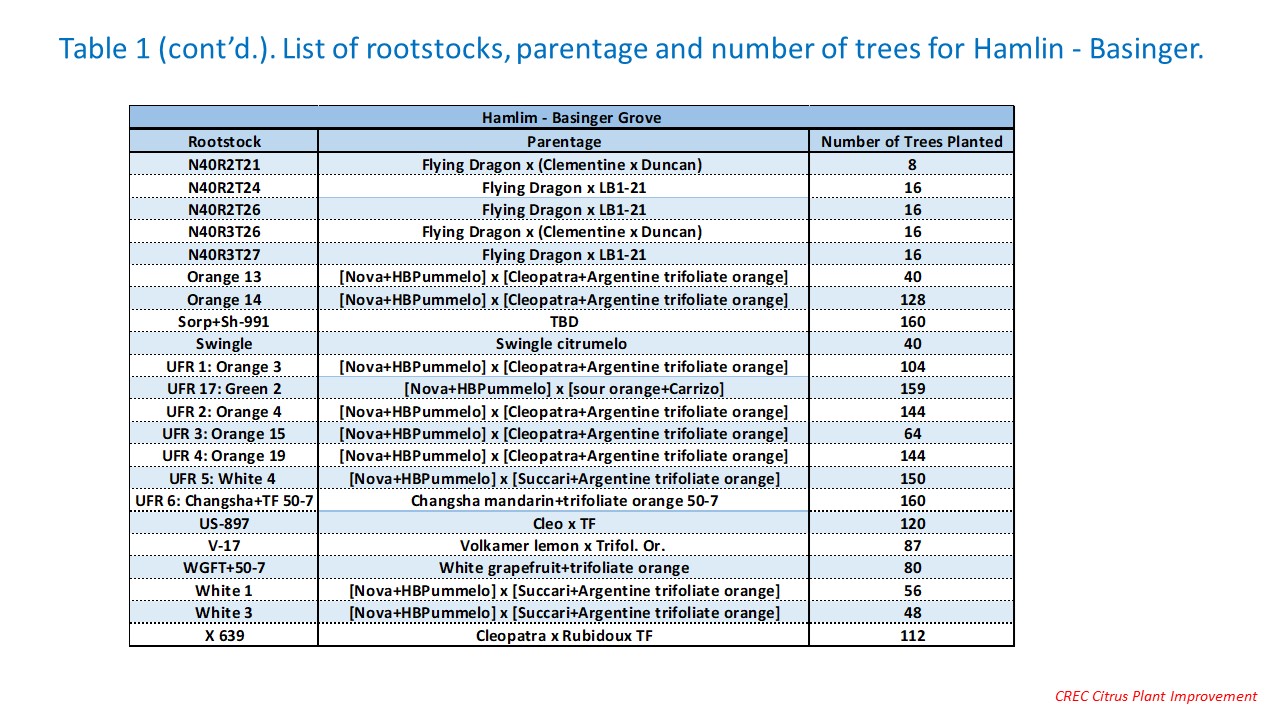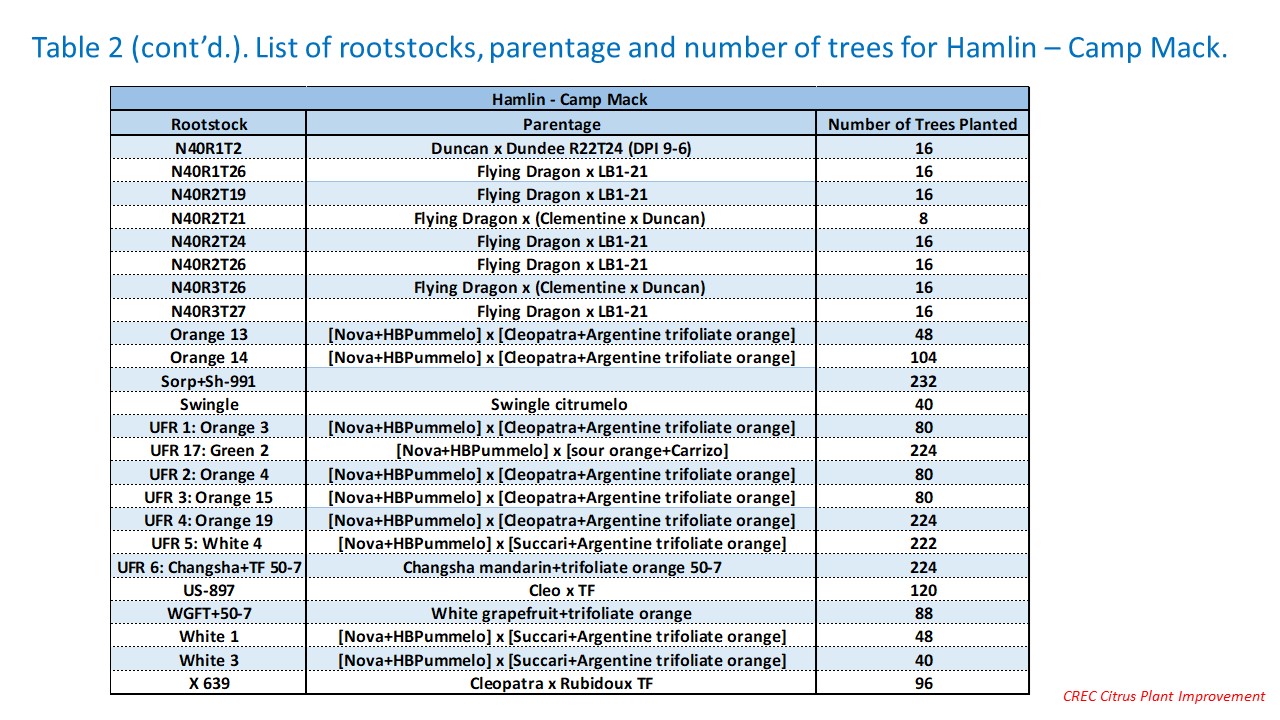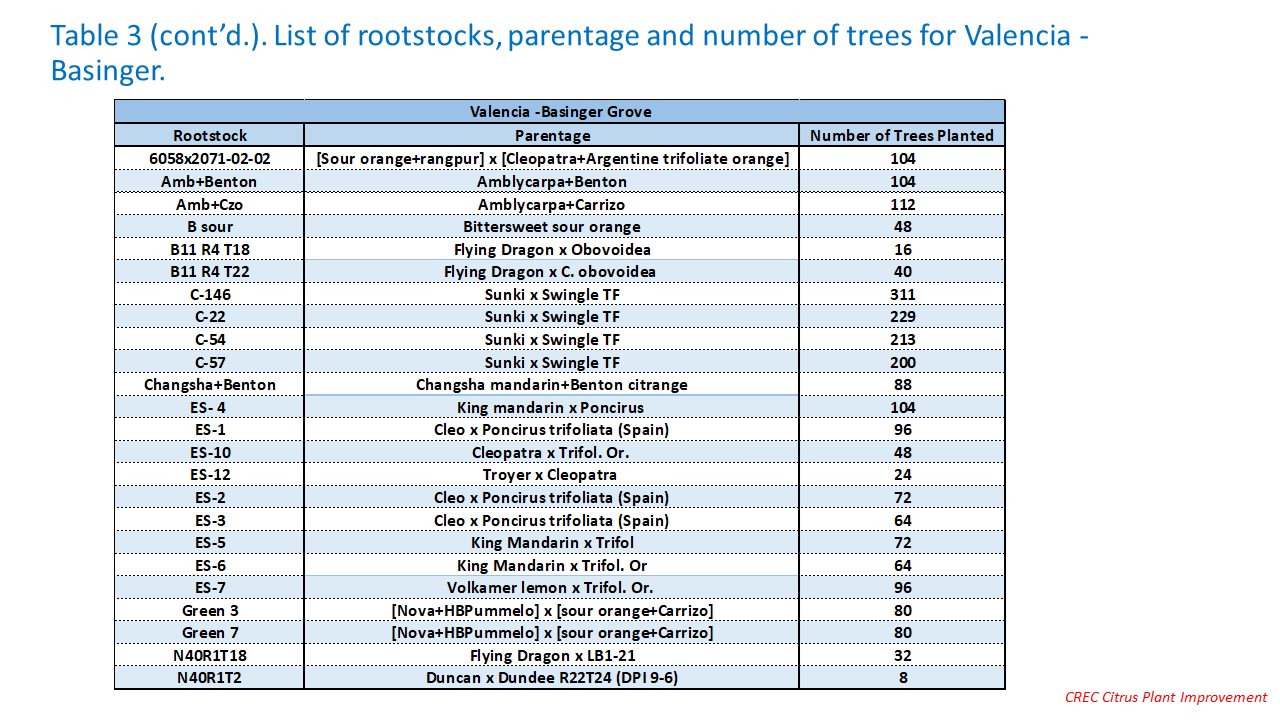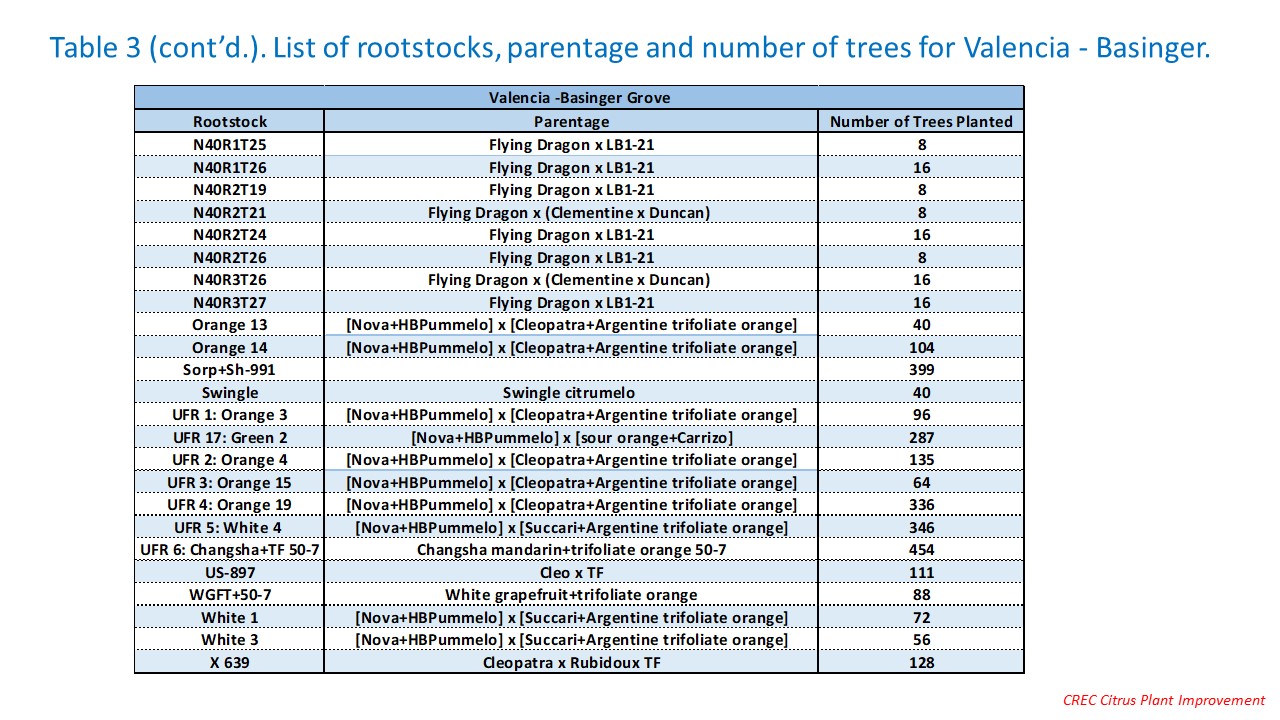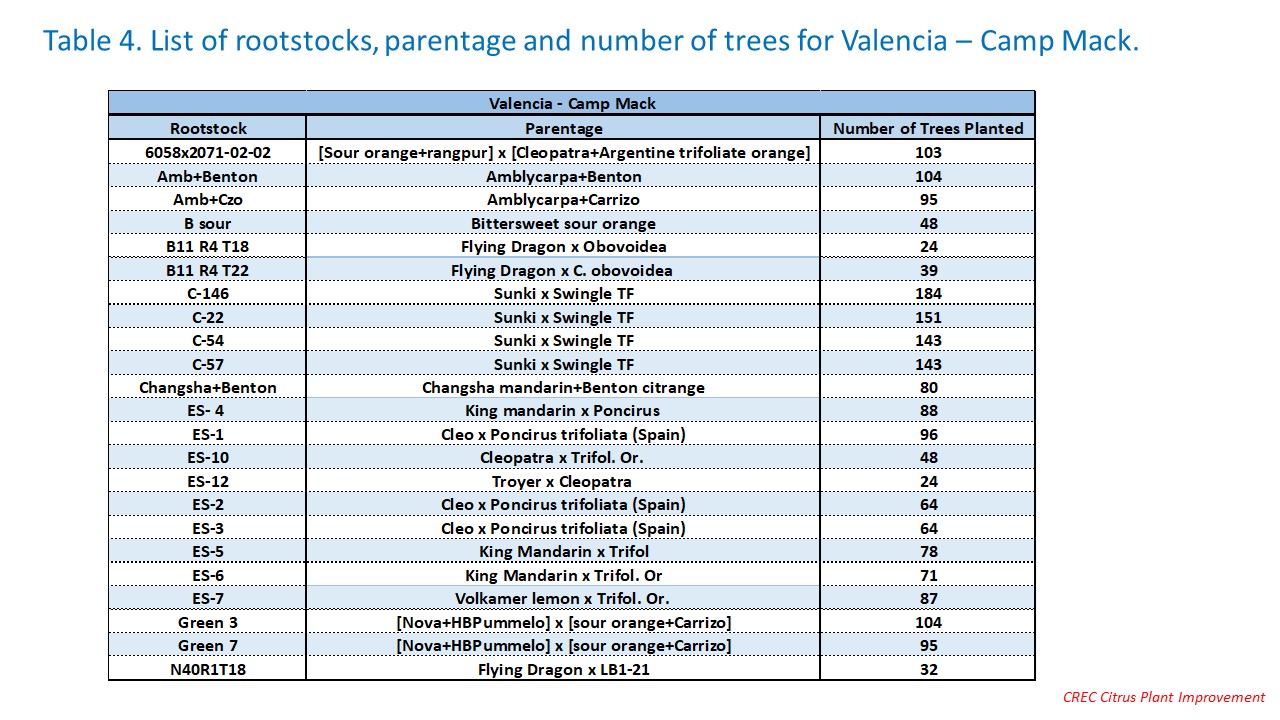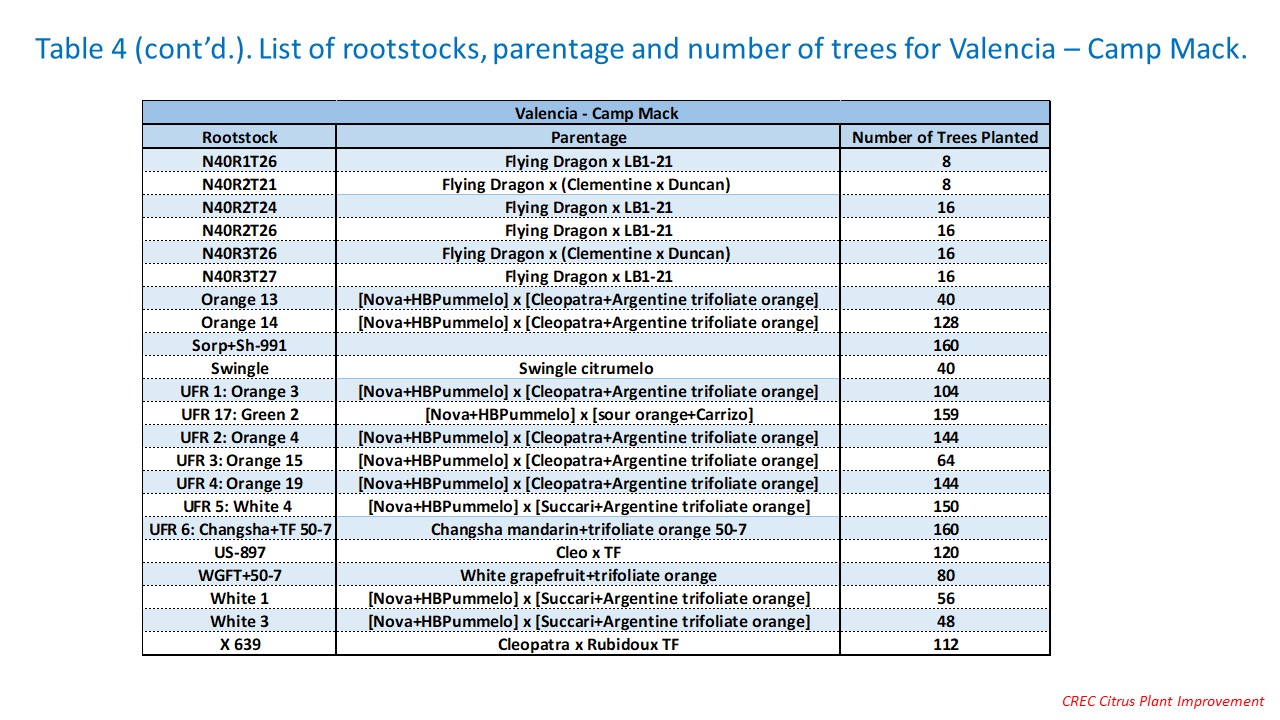Large-scale ‘Hamlin’ and ‘Valencia’ Rootstock Trials
Dr. Ute Albrecht - Dr. Bill Castle - Dr. Fred Gmitter - Dr. Jude Grosser
November 14, 2022 - Updated
August 25, 2022 - Revised
December 9, 2019 - Updated
December 7, 2018 - Posted
CREC Citrus Plant Improvement
Large-scale ‘Hamlin’ and ‘Valencia’ Rootstock Trials – Description
There are 4 trials, each ca. 10 acres, involving a total of about 17,000 trees. There are 'Hamlin' and 'Valencia' trials at each location, a typical Ridge (Lake Wales) or flatwoods site (Basinger). The trials, planted in 2015 at 8 x 22 ft or 8 x 25 ft, respectively, include numerous diploid and tetraploid rootstocks from the UF/CREC breeding program along with the best selections from the Forner breeding program in Spain, the C-Series rootstocks from California, USDA rootstocks, and commercial rootstocks for comparison, a total of 58* rootstock candidates, all amenable to seed propagation. The objective is to identify suitable scion/rootstock combinations for each site type with emphasis on combinations that will generate earlier returns.
(*) Limited tree numbers precluded planting 6 replications for all rootstocks; thus, data from only 32 were included in the published reports. Those rootstocks are the foundation of this report.
Large-scale ‘Hamlin’ and ‘Valencia’ Rootstock Trials - Summary
- Site 1: Basinger Grove, Highlands County, FL
- Site 2: Camp Mack Grove, Polk County, FL
- Scion - Rootstocks:
- Hamlin: 58 rootstocks
- Valencia: 53 rootstocks
- Date Planted: September 2015
- Design: Randomized complete-block, 10 replications
Plot size: 8 trees
Spacing [Basinger]: 8 x 25 ft. = 218 trees/acre; [Lake Wales]: 8 x 22 ft. = 247 tree/acre.
Data Collected:
- 2017/18: Tree size and tree health rating (Data available upon request).
- 2018/19: Tree height, canopy volume, yield, and juice quality (Valencia only).
- 2019/20: Tree height, canopy volume, yield, and juice quality.
- 2020/21: Tree height, canopy volume, yield, and juice quality.
TRIAL STATUS: Terminated
Hamlin* Basinger and Camp Mack Groves
*The data collected when the trees were 3-4 years old was published. The abstract from that publication appears on the next page.
Abstract [for the complete publication of the Hamlin trials across both sites, see link below*]
Most of the commercially important citrus scion cultivars are susceptible to Huanglongbing (HLB), which is the most devastating disease the citrus industry has ever faced. Because the rootstock can influence the performance of the scion in various ways, including disease and pest tolerance, use of superior rootstocks can assist citrus growers with minimizing the negative effects of HLB. The objective of this study was to assess rootstock effects on the horticultural performance and early production potential of ‘Hamlin’ sweet orange (Citrus sinensis) trees in commercial field settings under HLB-endemic conditions. Two field trials were conducted in different locations in Central and Southeast Florida. The trials were established in 2015 and included 32 diverse diploid and tetraploid rootstock cultivars and advanced selections. One trial was performed in Highlands County, FL, on a poorly drained flatwoods-type site. Another trial was performed in Polk County, FL, on a well-drained sandy Central Florida Ridge site. Horticultural traits including tree height, canopy volume, trunk diameter, canopy health, leaf nutrient content, yield, and fruit quality were assessed during the 2018–19 and 2019–20 production years. Significant differences were found among trees on different rootstocks for most of the measured traits, particularly tree vigor and productivity, but rootstock effects also varied by location. Rootstocks that induced large tree sizes, such as the diploid mandarin × trifoliate orange hybrids ‘X-639’, ‘C-54’, ‘C-57’, and ‘C-146’, also induced higher yield, but with lower yield efficiency. Most of the tetraploid rootstocks significantly reduced tree size, among which ‘Changsha+Benton’, ‘Green-3’, ‘Amb+Czo’, ‘UFR-3’, and ‘UFR-5’ induced high yield efficiency. Therefore, these rootstocks have the potential to be used in high-density plantings. However, trees on some of these small size-inducing rootstocks had a higher mortality rate and were more vulnerable to tropical force winds. This study provides important information for the selection of rootstocks with the greatest production potential in an HLB-endemic environment, especially during the early years of production.
Valencia* Basinger and Camp Mack Groves
*The data collected when the trees were 3-4 years old was published. The abstract from that publication appears on the next page.
Abstract [for the complete publication of the Hamlin trials across both sites, see link below*]
Huanglongbing (HLB, a.k.a. citrus greening disease) has reduced Florida citrus production and acreage substantially since its discovery in 2005. Most commercially important citrus scion cultivars such as sweet oranges are susceptible to the disease and no cure is available at present. This has increased the demand for HLB-tolerant rootstocks to retain tree health and maximize productivity through higher-density plantings. Polyploidy in citrus has been associated with reduced tree size and enhanced biotic and abiotic stress tolerance. This study compared the potential of tetraploid rootstocks with diploid rootstocks for inducing dwarfing of the grafted ‘Valencia’ orange scion and for enhancing productivity and tolerance to HLB. Two trials, one at a poorly drained site in south-east Florida and another at a well-drained sandy site in central Florida, were established in 2015. Tree size, canopy volume, yield, yield efficiency, fruit quality, leaf nutrients, and canopy health were assessed over three production seasons from 2018/19 to 2020/21. The different rootstocks varied significantly in their effects on tree size, yield, and yield efficiency. Diploid rootstocks, including the Florida industry standards Swingle, sour orange, X-639, and US-897, induced a larger tree size than tetraploid rootstocks. Most of the diploid rootstocks also induced higher cumulative yields than the tetraploid rootstocks. However, the latter induced higher yield efficiency and better fruit quality. A significant rootstock effect on canopy health and nutrient status was found, but this effect was not consistent across locations and production years. Tetraploid rootstocks did not display higher HLB tolerance than diploid rootstocks, including the industry standards. However, effective tree size control, high yield efficiency, and higher fruit quality induced by many of the tetraploid rootstocks revealed their potential to be used in high-density plantings.

.jpg)
